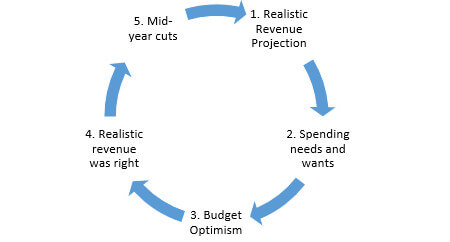The new calendar year is upon us and, while it is not usually the fiscal year end for most colleges and universities, it is a good time to consider resolutions nonetheless.
This is the time in our cycle of activities when budgeting is in full force. A prediction is made of this year’s grads and of those who will leave us otherwise. A continuous assessment occurs about new freshmen and transfer numbers to replace those who exit. Discount rates are applied to new students and returners (and should be applied to those who leave as well!) Numbers are flying around, with encouraging news and concerns popping up here and there. It is that annual rite of spring in higher ed. Success is defined by creating an accurate prediction of next year’s revenues and spending well within our plans.
If only that was always the outcome.
As required and desired spending requests roll in, the temptation is to project revenues on the high side of expectation to accommodate all the stuff we need and want to do so that the board gets a balanced budget. We feel good for now, delaying the pain by six to nine months when the fall semester turnstiles stop. Then, as if on queue, we announce that the enrollment folks missed their target. Too many students left, too few arrived, discounts were too high or all of the above. The rest of the year is then spent cutting wherever we can, with the practice that got us in the hole repeated next spring. And the enrollment folks are frustrated by the unwarranted attention.
At CFO Colleague, we are convinced that higher education is one of the easiest industries to predict. This is why the disciplines of manufacturing and health care were used to inform the COMP4cast multi-year planning model. The latest version (2017-A) uses linear regression to extrapolate new student enrollments so that plans for higher numbers will need to be be justified with concrete initiatives. While deploying this model with over fifty institutions we have learned the following:
1. Achieving a single year balanced budget is insufficient, particularly when our intake has been declining for a few cycles. We need to look at a series of pro-forma years and to use a proven mechanism to accomplish that. We recommend COMP4cast 🙂
2. Establishing historical relationships by class from fall to spring and from spring to rising fall has proven to be the best approach to explain and project population trends. Too many apply general percentages to the entire population even while knowing that freshmen are lost at a greater rate than Juniors.
3. Since faculty will be paid for at least another year and our inclination is to add staff, a generous voluntary separation package (VSP) tends to be a good idea. The payback is usually less than a year if designed correctly and timed appropriately. And, those who choose to leave are happier than those who are subject to involuntary separations. We’ve enjoyed great success in designing and deploying these programs.
4. The strategic plan must be connected to the budget process, with expectation that investment returns will stretch out over three or more years. Creating initiatives that purportedly will generate immediate returns is wishful thinking. Make budgetary room for innovation and expect some initiatives to fail.
5. If mid-year cuts are necessary for two or more years, the revenue projection process has failed; it was designed to fail.
We’ve worked with those who are doing a great job matching revenues with spending and with many who need help breaking the cycle described above. It is possible to turn things around, if you really want to and are willing to think outside the typical one-year budgetary box.
The COMP4cast model and accompanying instructions are available free on our website (http:cfocolleague.com) and we would be pleased to assist you in implementing best practices in the area of operational planning if you so desire. It’s a good chunk of what we do and we are seeing success in even the most challenging situations.
May your spring semester bring great things, in preparation for a successful fall. It’s a resolution worth keeping.




